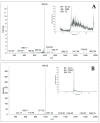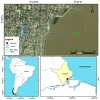First Detection of Microcystin-LR in the Amazon River at the Drinking Water Treatment Plant of the Municipality of Macapá, Brazil
- PMID: 31731712
- PMCID: PMC6891726
- DOI: 10.3390/toxins11110669
First Detection of Microcystin-LR in the Amazon River at the Drinking Water Treatment Plant of the Municipality of Macapá, Brazil
Abstract
Human poisoning by microcystin has been recorded in many countries, including Brazil, where fatal cases have already occurred. The Amazon River is the main source of drinking water in municipalities such as Macapá, where there is no monitoring of cyanobacteria and cyanotoxins. This study investigated the presence of cyanobacteria and cyanotoxins in samples from a drinking water treatment plant (DWTP) that catches water from the Amazon River. The toxin analyses employed ELISA, LC/MS, and molecular screening for genes involved in the production of cyanotoxins. The sampling was carried out monthly from April 2015 to April 2016 at the intake (raw water) and exit (treated water) of the DWTP. This study reports the first detection of microcystin-LR (MC-LR) in the Amazon River, the world's largest river, and in its treated water destined for drinking water purposes in Macapá, Brazil. The cyanobacterial density and MC-LR concentration were both low during the year. However, Limnothrix planctonica showed a density peak (± 900 cells mL-1) in the quarter of June-August 2015, when MC-LR was registered (2.1 µg L-1). Statistical analyses indicate that L. planctonica may produce the microcystin.
Keywords: DWTP; ELISA; LC/MS; Limnothrix planctonica; mcyE; microcystin; toxicity; water supply.
Conflict of interest statement
The authors declare no conflict of interest.
Figures





Similar articles
-
Occurrence of cyanobacteria and microcystin toxins in raw and treated waters of the Nile River, Egypt: implication for water treatment and human health.Environ Sci Pollut Res Int. 2015 Aug;22(15):11716-27. doi: 10.1007/s11356-015-4420-z. Epub 2015 Apr 10. Environ Sci Pollut Res Int. 2015. PMID: 25854210
-
Adsorption of microcystin-LR on mesoporous carbons and its potential use in drinking water source.Chemosphere. 2017 Jun;177:15-23. doi: 10.1016/j.chemosphere.2017.02.150. Epub 2017 Mar 1. Chemosphere. 2017. PMID: 28279901
-
Detection of various freshwater cyanobacterial toxins using ultra-performance liquid chromatography tandem mass spectrometry.Toxicon. 2010 May;55(5):965-72. doi: 10.1016/j.toxicon.2009.10.001. Epub 2009 Oct 28. Toxicon. 2010. PMID: 19878689
-
Liquid chromatography/negative electrospray ionization ion trap MS(2) mass spectrometry application for the determination of microcystins occurrence in Southern Portugal water reservoirs.Toxicon. 2013 Nov;74:8-18. doi: 10.1016/j.toxicon.2013.07.013. Epub 2013 Jul 26. Toxicon. 2013. PMID: 23896533
-
Determination of microcystin-LR, employing aptasensors.Biosens Bioelectron. 2018 Nov 15;119:110-118. doi: 10.1016/j.bios.2018.08.003. Epub 2018 Aug 8. Biosens Bioelectron. 2018. PMID: 30121422 Review.
Cited by
-
Cyanobacterial Blooms and the Presence of Cyanotoxins in the Brazilian Amazon.Toxins (Basel). 2025 Jun 11;17(6):296. doi: 10.3390/toxins17060296. Toxins (Basel). 2025. PMID: 40559874 Free PMC article. Review.
-
A Mini-Review on Detection Methods of Microcystins.Toxins (Basel). 2020 Oct 4;12(10):641. doi: 10.3390/toxins12100641. Toxins (Basel). 2020. PMID: 33020400 Free PMC article. Review.
-
Cyanobacterial Harmful Algal Bloom Toxin Microcystin and Increased Vibrio Occurrence as Climate-Change-Induced Biological Co-Stressors: Exposure and Disease Outcomes via Their Interaction with Gut-Liver-Brain Axis.Toxins (Basel). 2023 Apr 17;15(4):289. doi: 10.3390/toxins15040289. Toxins (Basel). 2023. PMID: 37104227 Free PMC article. Review.
-
Microcystin-LR in drinking water: An emerging role of mitochondrial-induced epigenetic modifications and possible mitigation strategies.Toxicol Rep. 2024 Sep 28;13:101745. doi: 10.1016/j.toxrep.2024.101745. eCollection 2024 Dec. Toxicol Rep. 2024. PMID: 39411183 Free PMC article. Review.
-
Global Occurrence of Cyanotoxins in Drinking Water Systems: Recent Advances, Human Health Risks, Mitigation, and Future Directions.Life (Basel). 2025 May 21;15(5):825. doi: 10.3390/life15050825. Life (Basel). 2025. PMID: 40430251 Free PMC article. Review.
References
-
- Whitton B.A., Potts M. Introduction to the Cyanobacteria. In: Whitton B.A., editor. Ecology of Cyanobacteria II: Their Diversity in Space and Time. Springer; Dordrecht, The Netherlands: 2012. pp. 1–13.
-
- Grewe C.B., Pulz O. The Biotechnology of Cyanobacteria. In: Whitton B.A., editor. Ecology of Cyanobacteria II: Their Diversity in Space and Time. Springer; Dordrecht, The Netherlands: 2012. pp. 707–739.
-
- Chorus I., Bartram J. In: Toxic Cyanobacteria in Water: A Guide to Their Public Health Consequences, Monitoring and Management. 1st ed. Chorus I., Bartram J., editors. E & FN Spon; London, UK: 1999.
Publication types
MeSH terms
Substances
LinkOut - more resources
Full Text Sources
Medical
Miscellaneous

